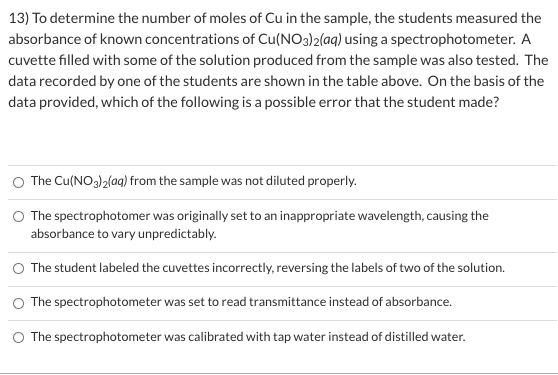13) To determine the number of moles of Cu in the sample, the students measured the absorbance of known concentrations of Cu(NO3)2(aq) using a spectrophotometer. A cuvette filled with some of the solution produced from the sample was also tested. The data recorded by one of the students are shown in the table above. On the basis of the data provided, which of the following is a possible error that the student made? O The Cu(NO,)2(aq) from the sample was not diluted properly. O The spectrophotomer was originally set to an inappropriate wavelength, causing the absorbance to vary unpredictably. O The student labeled the cuvettes incorrectly, reversing the labels of two of the solution. The spectrophotometer was set to read transmittance instead of absorbance.
13) To determine the number of moles of Cu in the sample, the students measured the absorbance of known concentrations of Cu(NO3)2(aq) using a spectrophotometer. A cuvette filled with some of the solution produced from the sample was also tested. The data recorded by one of the students are shown in the table above. On the basis of the data provided, which of the following is a possible error that the student made? O The Cu(NO,)2(aq) from the sample was not diluted properly. O The spectrophotomer was originally set to an inappropriate wavelength, causing the absorbance to vary unpredictably. O The student labeled the cuvettes incorrectly, reversing the labels of two of the solution. The spectrophotometer was set to read transmittance instead of absorbance.
Chemistry
10th Edition
ISBN:9781305957404
Author:Steven S. Zumdahl, Susan A. Zumdahl, Donald J. DeCoste
Publisher:Steven S. Zumdahl, Susan A. Zumdahl, Donald J. DeCoste
Chapter1: Chemical Foundations
Section: Chapter Questions
Problem 1RQ: Define and explain the differences between the following terms. a. law and theory b. theory and...
Related questions
Question

Transcribed Image Text:13) To determine the number of moles of Cu in the sample, the students measured the
absorbance of known concentrations of Cu(NO3)2(aq) using a spectrophotometer. A
cuvette filled with some of the solution produced from the sample was also tested. The
data recorded by one of the students are shown in the table above. On the basis of the
data provided, which of the following is a possible error that the student made?
O The Cu(NO,)2(aq) from the sample was not diluted properly.
O The spectrophotomer was originally set to an inappropriate wavelength, causing the
absorbance to vary unpredictably.
O The student labeled the cuvettes incorrectly, reversing the labels of two of the solution.
The spectrophotometer was set to read transmittance instead of absorbance.

Expert Solution
This question has been solved!
Explore an expertly crafted, step-by-step solution for a thorough understanding of key concepts.
This is a popular solution!
Trending now
This is a popular solution!
Step by step
Solved in 2 steps with 2 images

Knowledge Booster
Learn more about
Need a deep-dive on the concept behind this application? Look no further. Learn more about this topic, chemistry and related others by exploring similar questions and additional content below.Recommended textbooks for you

Chemistry
Chemistry
ISBN:
9781305957404
Author:
Steven S. Zumdahl, Susan A. Zumdahl, Donald J. DeCoste
Publisher:
Cengage Learning

Chemistry
Chemistry
ISBN:
9781259911156
Author:
Raymond Chang Dr., Jason Overby Professor
Publisher:
McGraw-Hill Education

Principles of Instrumental Analysis
Chemistry
ISBN:
9781305577213
Author:
Douglas A. Skoog, F. James Holler, Stanley R. Crouch
Publisher:
Cengage Learning

Chemistry
Chemistry
ISBN:
9781305957404
Author:
Steven S. Zumdahl, Susan A. Zumdahl, Donald J. DeCoste
Publisher:
Cengage Learning

Chemistry
Chemistry
ISBN:
9781259911156
Author:
Raymond Chang Dr., Jason Overby Professor
Publisher:
McGraw-Hill Education

Principles of Instrumental Analysis
Chemistry
ISBN:
9781305577213
Author:
Douglas A. Skoog, F. James Holler, Stanley R. Crouch
Publisher:
Cengage Learning

Organic Chemistry
Chemistry
ISBN:
9780078021558
Author:
Janice Gorzynski Smith Dr.
Publisher:
McGraw-Hill Education

Chemistry: Principles and Reactions
Chemistry
ISBN:
9781305079373
Author:
William L. Masterton, Cecile N. Hurley
Publisher:
Cengage Learning

Elementary Principles of Chemical Processes, Bind…
Chemistry
ISBN:
9781118431221
Author:
Richard M. Felder, Ronald W. Rousseau, Lisa G. Bullard
Publisher:
WILEY